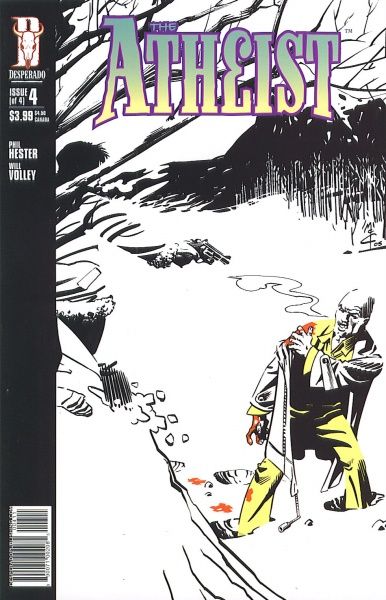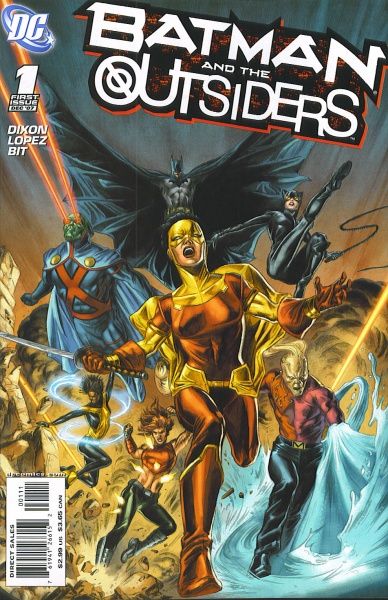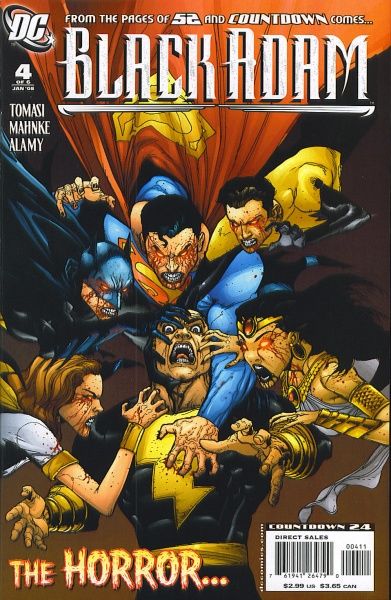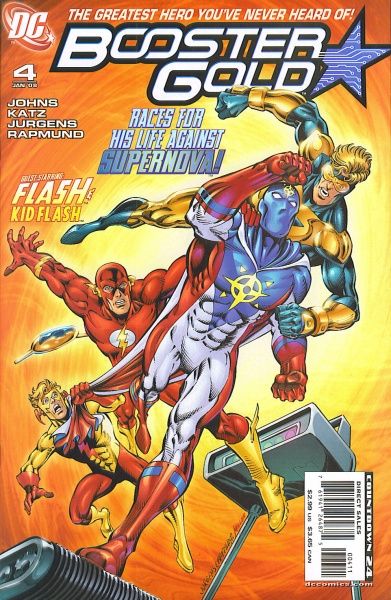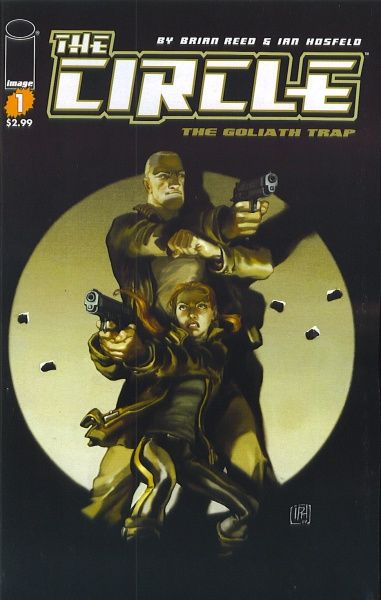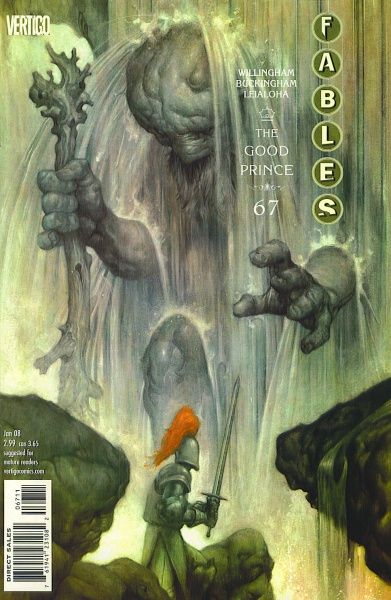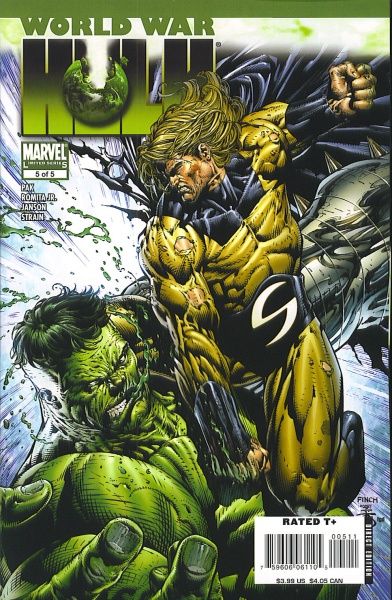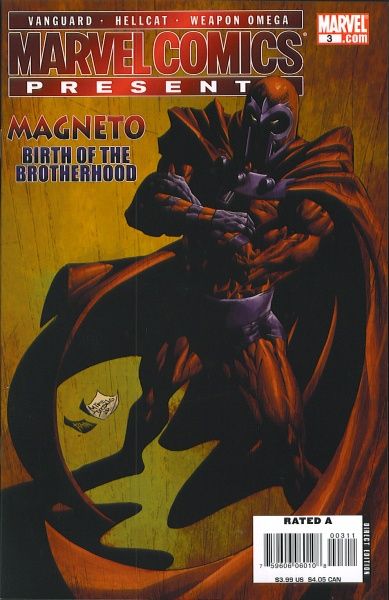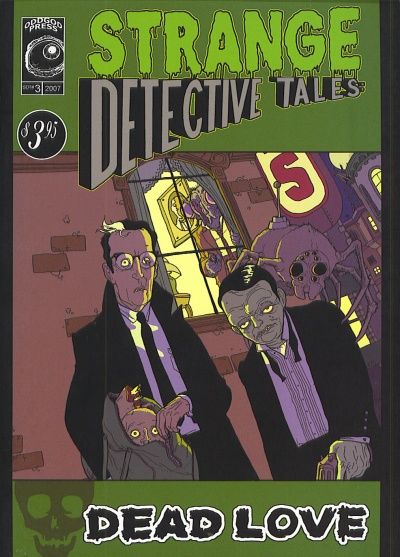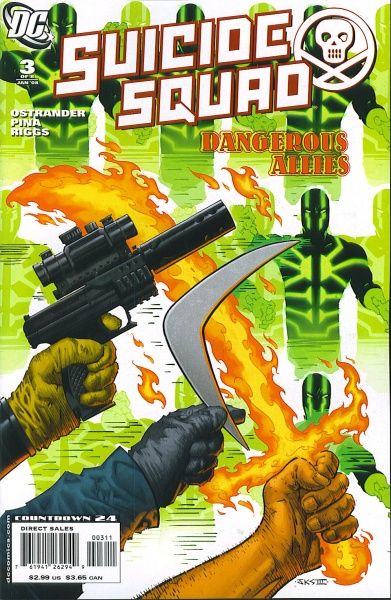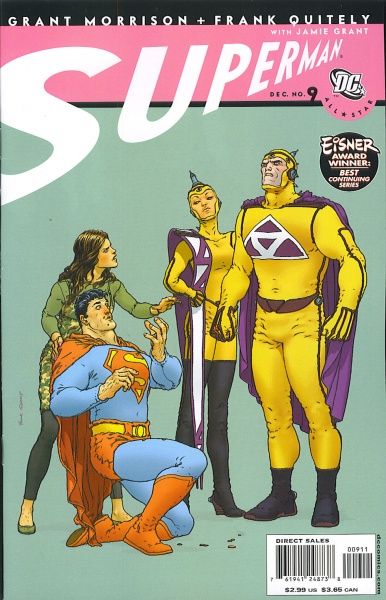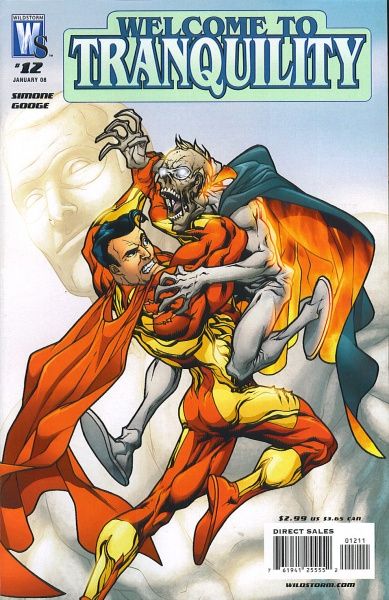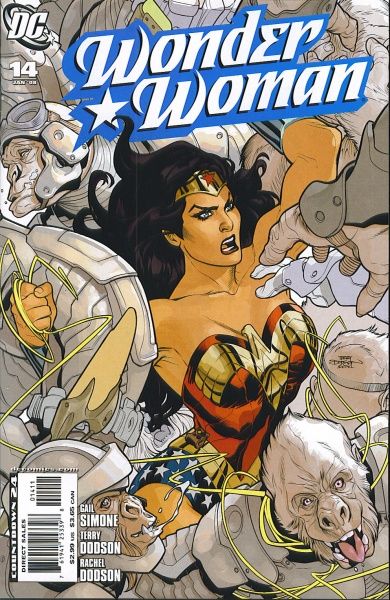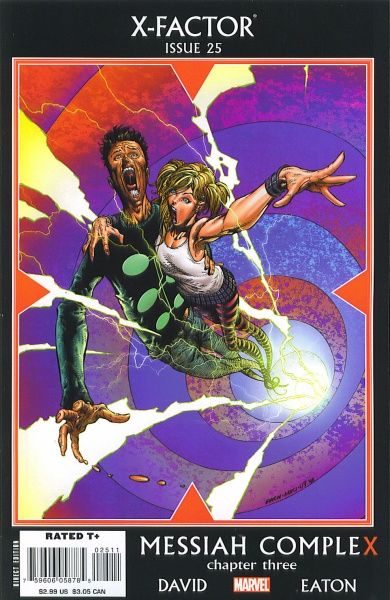It was a pretty big week in the comics world, and there were plenty of good books to go around. Did Iread the new Gail Simone title?You'll find out... once you go below the fold!
I've done this before, but I'll point out some reasons why I didn't buy the things some people suggested. I could not find Scott Pilgrim anywhere, so I imagine I'll have to track down the first volume on-line, unless I can find it in a library. I still doubt if I'll like it, but I'm reserving judgment. I guess I won't be able to find out why his friends are "retarded douchebags" until sometime in the future. I may read Salvation Run, but I didn't want to buy it, and I can only get five books for free each time, so maybe this weekend I'll check it out. I didn't buy the new Ex Machina trade because I buy the singles. I didn't buy the JLA: Ultramarine Corps trade because I have the individual issues (and they're very good, so if you don't have them, pick this up). I buy 100 Bullets in trade, and I may read the Badger book and Courtney Crumrin this weekend. I do get Queen & Country in trades, but I didn't see the latest one on the shelves and will have to hunt for it. I bought the first Brit trade and liked it, and will probably buy it in the same format later. And I did get Atomic Robo, but will review it for my other little column. S'alright? S'alright!
Okay, now for the books I did read!
The Atheist #4 (of 4) by Phil Hester and Will Volley. $3.99, Desperado Publishing.
Well over a year after the last issue, Phil Hester finally gets to finish his tale of a skeptic and his confrontation with something genuinely supernatural. Hester, in case you're wondering, is a fine comics writer, and his main character and the setup for this series was very good. Antoine Sharpe is a man who believes in nothing - hence the title - and is called in by the government when they come across something too weird for the normal agencies. Sharpe is, as he tells his new partner early on in the book, not smart but perceptive, and he can therefore get to the heart of the matter without being dazzled by the seemingly supernatural. When he's confronted by people who are apparently being possessed by the dead, he faces a case that isn't so cut-and-dried, because even Sharpe admits that there's something fishy going on. He and his partner, Melissa Nguyen, are heading to Winnipeg, where the dead have congregated, but they're opposed by the dead person orchestrating all of this - whose identity I won't give away, because it's quite interesting. In previous issues, Sharpe began to believe that the dead were coming back, but he still looked for a logical way to defeat them, because he doesn't believe their contention that they just want Winnipeg and nothing else. They're burning out the bodies of those they possess, see, because after having been dead for so long, they party like crazy people. So why wouldn't they continue to possess other bodies? In this issue, we find out what Sharpe's plan is and the lengths he's willing to go to stop the dead. It's chilling, actually, because we know that Sharpe is working for the greater good, and therefore we can understand what a bastard he can be, but we also like him, so it's upsetting to read what he ends up doing. In many ways, Sharpe is not unlike a typical Warren Ellis protagonist, but Hester does Ellis one better by not advertising that Sharpe can be heartless from the beginning. Often, in Ellis's books, the "hero" (or anti-hero, I suppose), talks about being a bastard and then reveals layers of emotion that humanize him. Hester does things in reverse, as Sharpe is human to us (a weird human, but still sympathetic) before he reveals layers of heartlessness. In this case, it works better, because we have come a little way with our hero and think we're prepared to like him. At the end of this book, we still like him, but we're a bit more frightened of him as well. It's a nice trick.
Will Volley's art is solid, but lacks the creepy verve that John McCrea, who drew the first three issues, had. McCrea, I guess, has been dealing with some personal things, and Volley does a decent enough job, but it's interesting that his slightly more "realistic" look doesn't fit as well with the story, which demands a slightly more abstract touch.
This is coming out in trade pretty soon, and now that it's done, I think the collected version is a good way to experience this. So look for it in a few months. It's a pretty neat little comic, and I think Hester is planning more stories, which would be cool.
Batman and the Outsiders #1 by Chuck Dixon, Julian Lopez, and Bit. $2.99, DC.
Chuck Dixon doing full-throttle action is a recipe for comics goodness, and for almost this entire issue, things were looking good. Then it went, if not horribly wrong, at least stupidly wrong, on the last page, which I will SPOIL below. But first, the good parts!
I don't like the idea of Batman running a team of covert operatives, because it kind of goes against the way he's been portrayed for the past 20 years (although I know he's supposed to be a bit less grim in the Brave New DCU) and, especially as relates to this book, it's another example of the Big Two mining the past instead of trying new things. Do we really need another iteration of this? And why must I ask that question every few months? Sigh.
But Dixon does a good job, making this a true covert team (as opposed to the original group, which was more of a superhero gang) that goes into the headquarters of an evil conglomerate (always remember, businesses in the DCU and MU are pure evil) to find out what's going on because something suspicious is, you know, up. This first issue is basically an infiltration exercise, with Batman coordinating things from Secret HQ (the Batcave?) while he argues with Thunder, who wasn't allowed on the mission. He gets some verbal jabs at her, everyone meets up and reaches the Super-Secret Center of the Tootsie Pop of the Evil Conglomerate, and then they find out what's in the place. Sigh. It's an OMAC. Yuck.
It's a nicely-done issue, because we need a good introduction to the team, some internal tension (which we need, or elseit's just not interesting), which we get because Batman doesn't allow Thunder to go on the mission, some good interaction between the characters, and something bad for them to fight. The reason it goes off the rails at the end is not really because of the presence of an OMAC. Well, it is, but just because it's an OMAC doesn't make it all bad. It's the suggestion, once again, that you can't enjoy a DC comic without reading other DC comics. Obviously, if we know who all these characters are, we have read DC comics in the past. But they do stuff in the book that lets us know who they are without really being all that knowledgeable about them. We can infer a great deal from how they infiltrate the building, and Dixon does a nice job keeping everything interesting while still showing us that Metamorpho, for instance, can change into different elements (and why is Rex wearing pants, anyway?). But the end, which is supposed to be a dramatic reveal (not really a cliffhanger, just a revelation) fails in the same way that the reveal at the end of last week's Annihilation: Conquest fails: it's a character that isn't menacing on its own, but is just menacing because of the readers' memories of it. Now, I have no doubt that both Abnett and Lanning (in Annihilation) and Dixon in this book will give us a reason to care about the bad guy in issues to come, but for me, at least, it's a bit annoying to turn to a final page and see [insert old character here]. My reaction is invariably NOT "Cool!" (which is what the writers want my reaction to be) but "Oh, that thing again. How retro." That's just me, I realize, and this book isn't really written for me, but I want to like it, and for all but one page, I did like it.
Despite that, I'll probably pick up issue #2 to see what the fuss is all about. As some of you know, I enjoy espionage kinds of comics, and Dixon can do that, if he wants to. I'll be curious to see if he wants to.
Black Adam: The Dark Age #4 (of 6) by Peter Tomasi, Doug Mahnke, and Christian Alamy. $2.99, DC.
This comic, on the other hand, isn't terribly interesting, and Mahnke's art, which is smoothed over a bit by Alamy's inks, doesn't save it. The cover, which looks as if Mahnke inked it, is the best part of the book. I know it's the fourth issue of a (say it with me!) six-issue mini-series, but I figured I'd check it out.
Here's the problem with this comic: the main character. Black Adam, at least in this particular issue, isn't really interesting enough for us to care about his problems. Tomasi gives us hints that he's "deeper" than just your standard super-villain, but he's still kind of boring. He's being chased by some operatives of some super-secret group who, at the beginning of the issue, have the drop on his "human" form. He manages to say his magic word and turn into Black Adam, and he finds a veterinarian who will stitch him up. When the bad guys find her and her nurse (I guess he's a nurse), Black Adam saves them. Not because he cares, but because he owes them a debt. Then he finds out theJSA is spying on him, and he puts a stop to that right quick.
It's not that this is bad, it's just that it's somewhat lacking in energy. It's a fairly standard story about a villain who is popular so he's given some redeeming qualities so he's easier to root for. I'm sure as a continuation of the first three issues, it works much better, but based on this one issue, I'm not of the mind to track those three issues down or buy the inevitable trade. Black Adam does bad things and some good things. The JSA is following him. That's about it. It's not enough.
The Black Diamond #5 (of 6) by Larry Young and Jon Proctor. $2.95, AiT/Planet Lar.
It's the fifth issue of a six-issue mini-series, so if you haven't picked any of the others up, you're not going to unless you're waiting for the trade. I will say that Young has done a good job in this series switching back and forth from crazy action to plot and character development, and after last issue, which ended with our hero's car on top of a train, this issue focuses on how he's going to continue now that his car is no longer in good shape to drive, as well as bringing the subplot of the stolen bag to a close in a humorous yet reasonable way. Dr. Don gets a new ride, everyone takes off again, and the army (as well as Dr. Don's wife, who's still being held hostage) move into position for next issue's grand finale. It should be quite fun and make us all think of Death Race 2000 and Damnation Alley and a bunch of other 1970s movies. The series might be a bit derivative, but unlike the derivative stuff from the Big Two, Young and Proctor are trying to make something new out of it. For the most part, they've succeeded.
I do have a question about the first two pages, though. Maybe Larry can come by and explain. On page 1, in the aftermath of the big crash, Dr. Don stands up and stretches as the tow truck takes his car away. His shirt is very clearly white. On the next page, the first panel shows him about to say something - he says, "Look, I ..." but then it appears that his shirt, which is now red, catches on fire. In the second panel he pulls the still-flaming shirt off. In the third panel, he stands with hands on knees and breathes a sigh of relief. In the fourth and final panel, his travelling companion, Cammie, steps on the red shirt and puts the fire out. What the heck happened on those two pages? Did Dr. Don's shirt actually change color and then spontaneously combust? It's a bizarre scene. Young has been providing the scripts to these comics, but crucially in this issue, it's missing. Confound it! ThenDr. Donneeds a new shirt and barters away something handy, even though he's wearing a T-shirt. Couldn't he have just worn that? Help me, Larry!
Booster Gold #4 by Geoff Johns, Jeff Katz, Dan Jurgens, and Norm Rapmund.$2.99,DC.
I could probably just reiterate what I said about Black Adam for this comic, although this is marginally better. Well, not the art, because Jurgens is merely competent, but the story is somewhat more interesting.But, as with BatO, this just isn't my kind of book. You may accuse me of hating superheroes, but that's just not true.What I don't like are simple adventure stories that tie too much into the continuity-heavy past. If the book is brilliant but tied to continuity, I can deal with it, butthis isn't brilliant. From what I've heard, this book is an exercise to visit key moments in DC's past and say, "Hey, look! how cool is this?" Booster, in this issue, must stop Supernova and"Rex Hunter" from negating the creation ofthe Flash, as Rex is attempting tostop the Justice League from forming so he and Supernova can save the world from all the bad guys the JLA fought and become great heroes.Yeah, it's about as silly as it sounds. After Booster saves theday (and learns the identity of Supernova, which is a HUGE SHOCK!), he tells Rip Hunter he wants to save Ted Kord's life, which is (irony alert!) just what RipHunter warned "Rex Hunter" not to do - mess with history. But then, in the next breath, he tells Booster they'll save Ted after they saveBarbara Gordon from getting shot by the Joker. Does anyone even listen to themselves in this comic? On page 5, Rip Hunter says, and I quote,"No matter what, we don't have the right to alter history the way we see fit,"but by the end, he's talking about changing history. He justifies it by claiming that Barbara's shooting was an "anomaly" that Supernova caused, but why is this different, good readers of the first three issues? Why does Rip Hunter get to do what he wants with history but others don't?
That's not why I don't like the book, though. It's just not anything more than a trip down memory lane. Hey, I can read old comics if I want that. Why should I buy a new one that does it?
The Circle #1 by Brian Reed and Ian Hosfeld. $2.99, Image.
Speaking of espionage comics, Brian Reed and Ian Hosfeld give us The Circle, which has a ton of potential. This is a pretty good first issue, too, as we begin with the theft of a missile train from a base in Kazakhstan which is blamed on an international mercenary group called the Circle. Wallace Christopher, a stringer for MI-5, does not believe the group was responsible, and he goes to Tokyo to prove it by finding the group's second-in-command. When he finds her, he tries to convince her of his good intentions, and we learn that the group is, naturally, being set up. Christopher is dragged into the group as the two leaders - that's them on the cover - head to Kazakhstan to figure out what happened.
Reed does a nice job setting up the entire situation by using Christopher. By using a reporter, he gives us the information about the Circle, which began as a rebel group in a Balkan country (presumably it's in the Balkans, although the actual country is made up) and expanded into a mercenary group. Christopher also fulfills the role of "outsider" to whom the audience is supposed to relate, and Reed uses him to fit us into the story well. There's some good action, but it's mostly to just break up the exposition. Next issue, presumably, there will be more gunplay. That's what we want!
Hosfeld's art is decent, even though he's called upon to draw a lot of talking heads. His Ilona looks a bit like a teenaged girl (maybe she is), but otherwise, he does a good job. From the few pages that feature action, he seems like he'll be able to handle that, too. It's a good-looking book.
It's a number one issue! There's no backstory to catch up on, so check it out!
Fables #67 by Bill Willingham, Mark Buckingham, and Steve Leialoha. $2.99, DC/Vertigo.
Well, it's another fine issue of Fables. Come on, people, they're all good! Ambrose reveals his big secret, which ought to keep the armies of the Empire from attacking him, but it doesn't. So he offers single combat, and he fights that troll there on the cover. You would think that would settle the matter, but of course it doesn't! So he plays his trump card, and we'll see if that works next issue. Oh, it's a bad thing a-coming!
The nice thing about this story and this issue in particular is that Ambrose keeps trying to settle things without fighting. He is showing himself to be a fine leader who has great power but doesn't want to use it because it would make things far worse, and it's kind of interesting watching as he shows us what great power he wields and how he resists it. Very neat storytelling by Willingham. Of course, because it's Fables.
Speaking of Willingham, I like the text piece in the back of this week's DC comics. In it, Double D goes to great lengths to prove that Salvation Run is not, in fact, a rip-off of Marvel's use of the Negative Zone as a prison. Is this a trend in comics? We saw it with the first issue of Mice Templar, and now this. "You ripped us off!" "Nuh-uh! I had this idea in first grade, and wrote about it in crayon in between cursive lessons!" "Oh, yeah? Well, I had the idea in the womb, man! I communicated it to my mother telepathically! Ask her!" "Well,I had the idea in one of my previous lives! While I was patching up the wounded in the Crimean War, I thought of this! Sosuck on it!" Where, I ask you, will it end??????
As I mentioned above, I didn't read Salvation Run. It could be the greatest comic ever!
World War Hulk #5 (of 5) by Greg Pak, John Romita Jr., and Klaus Janson. $3.99, Marvel.
This ended about as well as it could have, I suppose, despite the fact that someone dies, which is pretty cheap, and the fact that ol' Hulkster doesn't actually murder everyone in the Marvel Universe. This is still a fantastic mini-series, because it doesn't actually bend any characterization we've ever seen to fit a story - Pak figures a way out of his dilemma with a rather simplistic turn, which I'm not giving away but is pretty obvious. It might feel a bit disappointing, but once the real traitor is revealed, thereby taking away Hulk's plans for revenge against Mr. Fantastic and Tony Stark, it's the only way it can end, and I'm perfectly satisfied. It's not a great comic, but it delivers what it promises - Hulk bashing the hell out of people for five issues. And because that's pretty much all it promises, we have to turn to Romita's art, and luckily for everyone, he's incredible, especially in this issue, which is mostly the Sentry and Hulk beating on each other and destroying New York. Romita, who actually draws all his stuff (a staggering concept, I know), makes us feel every punch and bruise, and at the end, when every hero stands bleeding and beaten, we're almost out of breath ourselves. It's an amazing achievement, and makes the book better than it has any right to be. Pak keeps up, of course, but it's not like this is Shakespeare. Whatever you might think of Romita, he was probably the perfect artist for this book, because unlike some of the slicker artists of today, his fights seem real, and unlike the gritty artists, he can handle big goofy characters like Hulk and Sentry. The series doesn't end perfectly (how can it, really, when every mainstream superherostory leads into another?), but it ends well. It's a very good superhero comic book. And that's all it needs to be.
Marvel Comics Presents #3 byMarc Guggenheim, Dave Wilkins, and Francis Tsai; David von Allmen and Mico Suayan; Rich Koslowski and Andrea DiVito;Kathryn Immonen, Stuart Immonen, andWade von Grawbadger. $3.99, Marvel.
Here's something that may sound strange: I'm not sure when I'm going to stop buying this. "Greg," you say, "if you even think about dropping a book, you should." Yes, I get that, but it's not really the stories contained within that are making my decision difficult, it's the four-dollar price tag. I really like the lead story, "Vanguard," as our heroine, Stacy Dolan, finds even more things she doesn't like about the weird murder of the unknown suspect (including a fingerprint from someone who's supposed to be dead and whose possible resurrection will make Johnny Bacardi very happy), and the Immonens' Hellcat story continues to be goofy fun. I'm not as jazzed by Koslowski's Weapon Omega story, although it's decent enough, and von Allmen and Suayan's Magneto story is nothing special, and even irks me a bit because it takes place in the past, and inserting stuff into the past of characters bugs me. So the stories are entertaining on a certain level, and I'm intrigued by the murder mystery, but the price always bothers me. I'm definitely going to buy the nextissue, just because the Hellcat story ends, but "Vanguard" is 12 issues long, and I'm not sure if it's worth the trouble. I'm swirling in a storm of confusion!!!!!
Strange Detective Tales #1-3 by Jesse Bausch and James Callahan; Joel Priddy, Shane McDermott, and Patrick Godfrey; Ian Sampson; R. S. Paulette and Justin Alicea. $3.95, Oddgod Press.
I got these in the mail a few days ago, and I'd like to thank Jesse Bausch of Oddgod for sending them to me. The first two came out in 2005,but it appears all three are being offered again in Previews, or you could check out the web site for more information.
Anyway, the question always is: is it any good? Well, I can answer in one word: Hell yes. Okay, that's two words, but it's an emphatic Hell yes. Bausch writes a story that combines good old-fashioned noir with monsters, and the results are stellar. It's 1958, and the monsters (creeps, as they're called in the book) live in ghetto-ized sections of Los Angeles, trying to make ends meet. Renfield and Vorlic (who doesn't like to be called "Igor") are private detectives specializing in creep cases. Early on, Renfield (whose first name is Seward, in a nice tip of the hat to Dracula) gets a call about a girl he used to love who's gone missing. Everyone tells him to forget about Mary, because it didn't end well, but Renfield insists he's just looking out for her. The trail leads him to a bizarre strip club, where he is unwelcome, and into conflict with the alien mobsters who rule L.A.'s underworld (after having arrived in Roswell in 1947, of course). Eventually, Renfield also crosses paths with Howard Hughes, a Cyclops pimp, and an unusual farmer with odd livestock. It's somewhat of a twisty tale, but Bausch never lets it get too dense and confusing, and everything makes perfect sense by the end, even if it doesn't end perfectly well for all concerned. The great thing about the writing is how Bausch simply treats the creeps like regular people with strange problems - Renfield, for instance, is a vampire (obviously), but Bausch makes such a little deal about it that when, at one point, he's left in a field as day breaks, it takes a minute for us to realize why he's so pissed off. He's just a guy trying to make a buck who happens to be one of the undead.
Bausch's story is certainly interesting and compelling, but Callahan's art is brilliant. It has a bit of a Geof Darrow vibe, without the insanely detailed backgrounds. The details he puts into each character is amazing, from Vorlic's not-deliberate-at-all resemblance to Peter Lorre to the zombie client we meet on page 2, with half her face missing and a hole in her head through which we can see her brain. Half the joy of the book is gazing at the grotesque and oddly beautiful characters Renfield meets on the case. The aliens are modeled after the ones from Mars Attacks! (well, maybe not modeled, but they look similar), while Mary's landlady, who originally calls Renfield about her disappearance, is a gorgeous ghost with bleeding eyes. A shapeshifter's skin flows from one face to the next, and not in a refined, J'onn J'onzz kind of way, but in a melting wax kind of way. And when Callahan draws violent scenes, as he often does in this book, it's visceral and shocking, making us feel uncomfortable even when we're cheering (as when some bad guys get, well, eaten). Bausch's ideas are neat, but it's Callahan who makes the book shine.
Each issue is four dollars, but it's good value for your money. These books are thick, with the main story and some clever back-up stories (my favorite, "The Revenge of the Vermillion[sic]Claw,"is about a repentent super-villain who can't remember where he left bombs years ago and now wants to deactivate them), plus several very cool pin-ups. Plus, the covers and even the pages are good, solid stock, so the books won't fall apart. They're really a good deal when you consider that Marvel and DC are offering books for the same price (well, four cents more) that aren't as durable and don't have as many pages. Sure, they're in color, but these books look great even in black-and-white.
I strongly encourage you to check these books out. If you're a fan of crime fiction or horror, they're great, but even if you're not big fans, the story is still fun to read and the art is spectacular. You won't be sorry!
Suicide Squad: Raise the Flag #3 (of eight) by John Ostrander, Javier Pina, and Robin Riggs. $2.99, DC.
This is a weird ending to a three-issue arc within the longer eight-issue series about re-establishing the Suicide Squad. This is almost entirely about Rick Flag and how he got out of Skartaris and where he's been for three years. I'm trying not to think about the chronology, especially with the first issue's contention that the series began "two years ago." This is a solid issue, as Flag and Rustam fight dinosaurs and try to discover the way out of Skartaris. Flag also flashes back to when he first met Rustam, which explains the hatred they have toward each other, and then Waller recruits him into her new Suicide Squad. That's pretty much it.
Ostrander does his usual good job at making the characters real even in fantastic situations. Rustam has a real issue with Flag, even though Flag technically doesn't earn the hatred. But we sympathize with both men, and we realize what an untenable situation they're both in. Ostrander is good at making characters whoact like actual human beings and get into situations where no course is right and people need to muddle through as best they can. At the end, we have the foundation of a new team. What will happen next? I don't know, but I'll be reading to find out.
All Star Superman #9 by Grant "Bow Down to Me, Fanboys!"Morrison, Frank Quitely, and Jamie Grant. $2.99, DC.
Ah, the glory of All Star Superman. What the hell else is there to say. Buy it, you Philistines!
The God of All Comics gives us a sweet tale about Kryptonians who end up on Earth and "replaced" Superman when he went off to Bizarro World. Morrison, as he has done throughout the series, gives us a story in one issue that most writers today would take four to tell, and it stillmanages to be emotionally satisfyingand not feel rushed. Actually, it feels a bit rushedat the end, when the situation resolves a bit quickly, but it's still well done. Whenever the title lags a bit (as it did last issue with the less-than-excellent Bizarro story), Morrison gets it right back on track with a story like this.
Quitely's art is stunning as usual, but the one thing I wanted to mention about it is his superhero costumes, which actually look like real clothing. Nothing looks spray-painted on, and Superman's shorts are pants separate from the tights. Despite this slight bulkiness that we don't usually expect from superhero costumes, the characters still look majestic. Wow - you mean you don't need to draw someone naked and then just color the body green in order to pretend you drew a costume? Who knew? It's a minor detail that shows again why Quitely is so good.
Welcome to Tranquility #12 by Gail Simone and Neil Googe. $2.99, DC/Wildstorm.
It's the first (and better) and the two Gail Simone books this week! Yes, I wrote "better"! You know, deep in your heart, that it's true!
Simone concludes her latest story, which features Satan and the dead rising and horrible things happening, and she does it in fine fashion, as the bad guy is defeated, of course, but not without some shake-up of the cast. Simone, as usual, does a nice job making sure everything leads to something else, keeping all the balls in the air well, and even in a crowded book like this, making sure the characters carry the load. We expect certain things from the cast, and when we get them, we're not upset, just satisfied that someone knows how to write a solid superhero book. Unlike the first arc, which was supposed to be a bit more mysterious (being a murder mystery and all), nothing in this arc is too shocking, but Simone has done such a nice job with the characters that by the time we get to this issue, we're invested in what is happening and we care about how each character resolves his or her personal problem in the context of the larger story. And Simone makes it all work. I've said this before and I'll say it again - this is a better book than her work with established characters because she appears to care more about them, and therefore she makes us care.
It's unclear whether the book has been canceled or not. I guess "not" is the party line, but we'll see. Another issue hasn't been solicited yet, but it would be nice if Simone could continue with this, because it's a better-than-average superhero comic in a landscape of mediocrity.
Wonder Woman #14 by Gail Simone, Terry Dodson, and Rachel Dodson. $2.99, DC.
And then there's Wonder Woman, which, apparently,has been longed for by everyone in the comics blogaxy except for yours truly. It's not that I don't like Diana or Simone or the Dodsons, it's just that I don't see the need for Wonder Woman to be in a good comic. It's the same way that I don't get why sports pundits always say that Notre Dame or the Dallas Cowboys or, now, the Boston Celtics being good is good for their respective sports. It's only good because sports pundits like talking about those teams. Personally, if the Fighting Irish or Cowboys never won another football game, I'd be really happy (I don't care as much about the Celtics, so whatever). I get that Wonder Woman is supposed to be part of the "Big Three" of DC, but that's more of a marketing strategy by the corporate bigwigs than anything organic. She's like Captain America - far more interesting as an icon than as a character, and it takes a good writer to make her interesting. It doesn't matter to me at all if she's in a good comic or not, even though apparently many people pine for it.
Similarly, I don't get why Simone is supposed to be the savior of Wonder Woman. I haven't read the previous thirteen issues of this particular series, but I guess they're a bit of a train wreck. Well, I own almost 200 issues of a Wonder Woman comic that was, for the most part, pretty darned good. Some people object to Len Wein and George Perez's "re-imagining" of the Amazons in the 1980s, especially because WW was retconned out of DC history while Batman and Superman were allowed to retain their status. Well, Superman wasn't, but that's neither here nor there. Perez's run on the title is notable fortwo mainthings: he steeped the stories in Greek myth, which is a great idea; he brought Diana into the world as a messenger of peace and gave her connections in the "real world," from Julia Kapatelis to Mindi Mayer. The theme of grounding Diana in the "real world," which Simone has Diana rhapsodizing about in this issue, has been done, and better. Even early in Messner-Loebs' run, before Deodato turned the book into a weird porn comic, Diana worked at a fast-food restaurant. I get that plots are recycled over and over in comics, but this idea of living among the little people has been a significant part of her life in recent years, so it feels odd that she puts such a premium on it. I skipped the Byrne years (shudder), but the post-Byrne issues, leading into Jimenez's decent run and then Rucka's, are pretty good in showing the many facets of Diana, and Rucka's, especially, where she's an ambassador, did an excellent job with her mission to "Man's World." So why do people seem to think that Wonder Woman needs to be "fixed"? Because she's had 13 crappy issues of a new series? Because the Powers That Be made her kill Maxwell Lord? I'm not sure why, but it's strange that Simone's run is being seen, even before it begins, as the redemption of the character, because I don't see why she needs to be redeemed.
"Just shut up already and tell us if it's any good, sir!" you bellow, frustrated by my trip down memory lane. Well, it's not bad. It's a fairly decent superhero comic, but I'm not sure it's a very good Wonder Woman comic. I do like the part where Diana decides not to fight the gorillas on the cover but instead offers them friendship, but it's not like she doesn't fight them for several pages before that, just to give the Dodsons some groovy fight scenes to draw. And Captain Nazi is just ... well, idiotic, so the ending, which has some promise, is hampered by the fact that we're reading about someone named "Captain Nazi." Simone does a decent job with fitting into the established reality of Diana, so we get the absolutely stupid plot point that she doesn't have powers when she's out of costume, another relic from the 1970s that, like the Hall of Doom, was goofy and stupid when it first appeared and hasn't gotten any less goofy and stupid just because 30 years have passed. By far the most interesting part of the book was the Themyscira prologue, which indicates that Simone has some neat ideas about what's to come, but otherwise, this is an okay superhero comic that isn't a very good Wonder Woman comic. Most superhero books need to have something more - a reason to care about the particular characters in the book. Perhaps only Batman can carry a book in which he's not terribly interesting. But Wonder Woman needs to be something different, and she has been in the past, which is why the apparently somewhat-maligned post-Crisis reboot is a very interesting comic. (I'm not thinking of any specific criticisms about the post-Crisis book, so I won't link to anything, but it seems that whenever it comes up, it gets maligned. I could be reading toofew opinions to make a generalization. Maybe everyone who reads this post loves the post-Crisis reboot.) I think Simone might have been better suited with a single issue about why we should care about her version of Wonder Woman. When a new writer takes over, especially on a book that has been critically savaged and commercially inert, they need to make clear that they have a solid understanding of the character and give us a reason to buy their run. Simone may have that, of course, and this issue is marginally interesting enough that I might come back to it next time.But for the most part, I get the sense that this is a generic adventure story, and I've seen those before. Ihope Simone doesn't let me down, but you know what?it's not going to be the end of the world if she does. Wonder Woman could vanish from the publishing world and it wouldn't make any difference to me. USC could disband their college football team and college football would continue, healthy as ever. That's just the way it is.
X-Factor #25 by Peter David, Scot Eaton, and John Dell. $2.99, Marvel.
That's a very cool cover. Finch does a nice job, making this scene far more interesting than the one inside.
This is not a good X-Factor issue, but I hope no one expected it to be. David has been pressed into service of the mega-crossover, so he does his best to get the gang into the book, even though we have a couple of plot points that are shoehorned in. Cyclops tells the New X-Men to stop whining (of all the people to tell someone else to stop whining) because they'll get into "action" soon enough, which is a necessary scene because the next stop in the crossover is in the pages of New X-Men; and Wolverine, Storm, and Nightcrawler talk to Amelia Voght (it's an Amelia Voght sighting!) about where theAcolytes are. David gets those over with as quickly as possible, and the rest of the issue does a nice jobgetting Rictor in with the Purifiers and sending Madrox's duplicates (along with Layla, who grabs one of them) off to alternate timelines to see what's going on. Of course, Forge (who sent the dupes into the alternate timelines) didn't plan on them comingback, so the fact that Layla went with one is a bit of a problem. Oh well, we'll see what happens soon enough. It was kind of cool to see Forge, wasn't it? I like how he has a machine that can transport people to alternate realities just lying around. I always love that about comic-bookscience - "Yeah, I have this timemachine here, collecting dust.I'm already bored with it." One of the best things to mock about Spider-Man 2 is that Octavius invented those arms and just passed it off asmere tinkering in order to get to his mainproject. Hey, Otto,patent those arms and you'd have enough moneyto create dozens of miniature suns, ya nut!
Anyway, it's the third chapter of a mega-crossover. We're still in the setting-up phase. It's fine, even if it's not a great individual comic. It's what you expect, and that's okay.
So, another busy week in the books. If I'm incommunicado for the next six months, it's because I'm trying to read five pages of The Black Dossier. Man, that thing is dense! Wish me luck. I'll check back in once I've gotten through that lost Shakespeare play! Sheesh, Alan Moore makes my head hurt.


